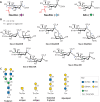Recent progress in targeting the sialylated glycan-SIGLEC axis in cancer immunotherapy
- PMID: 37133224
- PMCID: PMC10246440
- DOI: 10.20892/j.issn.2095-3941.2023.0046
Recent progress in targeting the sialylated glycan-SIGLEC axis in cancer immunotherapy
Abstract
Malignant tumors are complex structures composed of cancer cells and tumor microenvironmental cells. In this complex structure, cells cross-talk and interact, thus jointly promoting cancer development and metastasis. Recently, immunoregulatory molecule-based cancer immunotherapy has greatly improved treatment efficacy for solid cancers, thus enabling some patients to achieve persistent responses or cure. However, owing to the development of drug-resistance and the low response rate, immunotherapy against the available targets PD-1/PD-L1 or CTLA-4 has limited benefits. Although combination therapies have been proposed to enhance the response rate, severe adverse effects are observed. Thus, alternative immune checkpoints must be identified. The SIGLECs are a family of immunoregulatory receptors (known as glyco-immune checkpoints) discovered in recent years. This review systematically describes the molecular characteristics of the SIGLECs, and discusses recent progress in areas including synthetic ligands, monoclonal antibody inhibitors, and Chimeric antigen receptor T (CAR-T) cells, with a focus on available strategies for blocking the sialylated glycan-SIGLEC axis. Targeting glyco-immune checkpoints can expand the scope of immune checkpoints and provide multiple options for new drug development.
Keywords: SIGLEC; anti-SIGLEC antibodies; glyco-immune checkpoint; high affinity SIGLEC-ligands; sialylated glycan.
Copyright © 2023 Cancer Biology & Medicine.
Conflict of interest statement
No potential conflicts of interest are disclosed.
Figures



Similar articles
-
Targeting glyco-immune checkpoints for cancer therapy.Expert Opin Biol Ther. 2021 Aug;21(8):1063-1071. doi: 10.1080/14712598.2021.1882989. Epub 2021 Feb 8. Expert Opin Biol Ther. 2021. PMID: 33502268
-
Targeting sialic acid-Siglec interactions to reverse immune suppression in cancer.Glycobiology. 2018 Sep 1;28(9):640-647. doi: 10.1093/glycob/cwx108. Glycobiology. 2018. PMID: 29309569 Review.
-
The sialoglycan-Siglec glyco-immune checkpoint - a target for improving innate and adaptive anti-cancer immunity.Expert Opin Ther Targets. 2019 Oct;23(10):839-853. doi: 10.1080/14728222.2019.1667977. Epub 2019 Sep 23. Expert Opin Ther Targets. 2019. PMID: 31524529 Review.
-
Siglec Signaling in the Tumor Microenvironment.Front Immunol. 2021 Dec 13;12:790317. doi: 10.3389/fimmu.2021.790317. eCollection 2021. Front Immunol. 2021. PMID: 34966391 Free PMC article. Review.
-
Sialic Acid-Siglec Axis as Molecular Checkpoints Targeting of Immune System: Smart Players in Pathology and Conventional Therapy.Int J Mol Sci. 2020 Jun 19;21(12):4361. doi: 10.3390/ijms21124361. Int J Mol Sci. 2020. PMID: 32575400 Free PMC article. Review.
Cited by
-
The Potential of Siglecs and Sialic Acids as Biomarkers and Therapeutic Targets in Tumor Immunotherapy.Cancers (Basel). 2024 Jan 10;16(2):289. doi: 10.3390/cancers16020289. Cancers (Basel). 2024. PMID: 38254780 Free PMC article. Review.
-
Mechanistic and Therapeutic Implications of Protein and Lipid Sialylation in Human Diseases.Int J Mol Sci. 2024 Nov 7;25(22):11962. doi: 10.3390/ijms252211962. Int J Mol Sci. 2024. PMID: 39596031 Free PMC article. Review.
-
Enzyme-Sialylation-Controlled Chemical Sulfation of Glycan Epitopes for Decoding the Binding of Siglec Ligands.J Am Chem Soc. 2024 Oct 30;146(43):29469-29480. doi: 10.1021/jacs.4c08817. Epub 2024 Oct 17. J Am Chem Soc. 2024. PMID: 39417319 Free PMC article.
-
Regulatory Roles of Long Noncoding RNAs in Arterial Stiffness and Hypertension.Hypertension. 2025 Jul;82(7):1195-1207. doi: 10.1161/HYPERTENSIONAHA.124.23580. Epub 2025 May 29. Hypertension. 2025. PMID: 40438943 Free PMC article.
-
Regulatory Roles of Long Non-Coding RNAs in Arterial Stiffness and Hypertension: Insights from Two African American Studies.bioRxiv [Preprint]. 2024 Aug 12:2024.08.11.607492. doi: 10.1101/2024.08.11.607492. bioRxiv. 2024. PMID: 39372764 Free PMC article. Preprint.
References
-
- Mise Y, Hamanishi J, Daikoku T, Takamatsu S, Miyamoto T, Taki M, et al. Immunosuppressive tumor microenvironment in uterine serous carcinoma via CCL7 signal with myeloid-derived suppressor cells. Carcinogenesis. 2022;43:647–58. - PubMed
Publication types
MeSH terms
Substances
LinkOut - more resources
Full Text Sources
Medical
Research Materials
